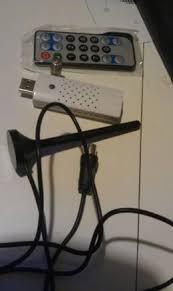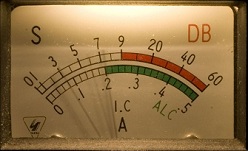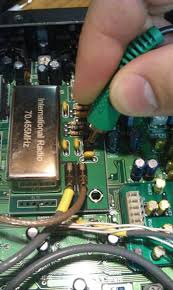My thoughts on the works of others – and the performance and uses for this unique idea…
Allright folks- Barry asked for it, so here it is:
I was I the market for a spectrum analyzer after K9SD offered one up for about $150 – though his had the frequency range of 10 kHz – 150 MHz. Somehow, this came up in a discussion with Barry, when he mentioned the “funcubedongle” – well, I’ve looked at that thing, and it cost way too much for me to even consider it. While $220(ish) is not bad by most standards, I’d rather buy camera lenses. At this point a message came across my IM at work prompting me to look up “DVB-T” on ebay. I did some googling, and found that, as many of you may have at Dayton, these cheap USB TV receivers have been re-purposed as dirt cheap SDRs – as long as they have RTL2832U and Elonics 4000 chipsets
I bought the unit pictured below from “nooelec” on eBay (ships form New York)– it was about $27, which may be a bit more expensive than some of the other “ships from outside USA” models with the same chips, but I had it a bit quicker than if I had to wait for it… the other downside is that this thing is slightly larger than other models… so a USB extension cable might be in order.

Step 1: open the package and throw out the remote. Not going to be going overseas to watch TV with it, so it is of no use… or give it to the 3 year old to destroy.
One more note about this unit – it comes with a PAL to F RF adaptor – one of the few RF adaptors I did not have at home or in the lab… PAL looks like an RCA connector, bit with a more slender center conductor… and since I don’t want to solder on the board, finding a kit that comes with the adaptor is pretty important for later use. Based on my initial googling, it seemed as if everyone was using Linux and gnu radio to use this thing. I use a Dell D630, which has a nice hard drive tray system, which allows me to switch hard drives quickly, so I set up a second drive with Ubuntu, and installed Gnu radio and the other recommended add-ons.
I tinkered with this for a couple of days, believing that it was working (and it may have been) – but gnu radio is not especially friendly for quick tuning and mode changes – but it’s very adaptable if you know python or just want to tinker. This lasted about 2 days before I threw “windows” into my “DVB-T SDR” search string. Interesting… Winrad can be used with this thing, with only a simple driver addition, so winrad sees it as an input device… I thought about including some of the instructions here, but I’ll include some links, and a link to a zip file with whatever you’ll need.
The basic process is to install the winrad based program of your choice, install a driver, modify the DLL (at least, if you get the same error message I was getting… see the PDF file included in the zip file linked in the end if it won’t tune and acts stupid)
At any rate, I already had winrad installed on one of my computers, so running through the windows installation procedure was simple… after a day of getting irritated that it wouldn’t let me tune, and wasn’t receiving well, I noticed that there was an error log in the driver window (you’ll see this when you install it!)… searched for the error message, and found a solution… tuned 162.475, rotated the dipole I had, and it finally worked! Parked it on 144.39 at my desk (middle of a metal building – not exactly a good place to do receiver tests) – and started getting APRS traffic..
Next, I had an idea… not long ago, I started down the path of wanting to install an IF tap on my FT1000 for a bandscope. Thus the reason I built the 455 kHz softrock (thanks to Dave C for the input transformer help!)… the original author mentioned on http://www.pensioneitaliacapri.com/ham/pan.adapter/la-braciola.htm that his original plan was to build his bandscope around the 1st IF at 70 MHz… but mentioned that, at the time, there was not a readily available low cost SDR for VHF frequencies .. guess this changed now!
Just for grins, I popped open the radio, wired an RCA cable to the SDR, and started probing around the roofing filter (non-conducted probing – don’t want to deal with loading the IF yet or the possibility of blowing up the SDR yet – give me some time). Here’s the probing –
I quickly found that the amplifier seemed to be the best place to probe – tuned the radio through the broadcast bands, ham bands, etc. – and verified that I could demodulate what the radio was tuned to (or close to, since I had a LITTLE more bandwidth than the regular FT1000 receive bandwidth)… I have a feeling that I will get better results for SDR tunable bandwidth (panadaptor bandwidth) if I can connect the SDR ahead of the roofing filter..
Here’s the resulting spectrum from 40M (7.230) on field day – I’d say it works very well – and coupled with an oscilloscope on the I.F. tap – it makes for an interesting performance monitoring situation – both of the other station’s signal, as well as my own.
I’ll leave it up to you to find winrad, HDSDR, or WRPlus as you desire…. Though SDR# (“SDR Sharp”) is quickly becoming a favorite because of it’s simple interface. It can be found at:
As SDRSharp progresses, so is the driver software – it is essentially plug and play – no need to mess with all of the drivers anymore. I will admit that HDSDR has some small benefits when acting as a bandscope. It sure would be nice if they had a time domain (oscilloscope) display – then I would not need a separate oscilloscope connected to the 455 kHz or 8 MHz IF taps.
Additionally, a quick-start guide can be found here: www.rtl-sdr.com/rtl-sdr-quick-start-guide/ Keep in mind that it is critical that a RTL SDR chipset is used for many of these guides!
The end result? This stupid thing was up and running and behaving with software faster than my softrock.
At this point, I have done no comparisons or calibrations to see how well it responds to a field (somewhere I actually have a set of plots over frequency for various power levels into my scanner to see how the RSSI is calibrated – and it is not… but I digress, again)


